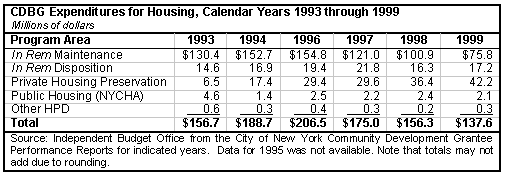
In May, the City of New York released its calendar year 1999 Community Development Block Grant (CDBG) Performance Report, which shows that New York City has once again spent the majority of this federal grant on the rehabilitation and maintenance of housing. Funds dedicated to the maintenance of in rem housing have significantly decreased, however, with more monies devoted instead to the rehabilitation and maintenance of private housing.
Background
The Community Development Block Grant program was established by Congress through the Housing and Community Development Act of 1974 to fund a wide range of activities directed toward revitalizing neighborhoods and promoting economic development. Awarded as an annual grant to municipalities by the United States Department of Housing and Urban Development, the CDBG program allows communities to develop their own funding priorities, but requires that they give precedence to activities that benefit low- and moderate-income households. In general, municipalities are allowed to use the grant to fund housing rehabilitation and maintenance, public services, public facilities and infrastructure improvements, economic development activities and related planning and administrative costs.How New York City Spends its CDBG
Revenue received by New York through the CDBG program supports activities at 19 different agencies and accounts for about 5 percent of the city's federal categorical aid. In calendar year 1999, the city spent $211.6 million in CDBG funds. IBO's analysis of the 1999 CDBG expenditures shows that $137.6 million, or 65 percent of the total, was spent on housing rehabilitation and maintenance. This was followed by expenditures on public facilities and infrastructure (11.5 percent), public services (11.2 percent), and planning and administration (10.8 percent). Finally, 1.6 percent was spent on economic development initiatives.

Focus on Housing
The Department of Housing Preservation and Development (HPD) uses CDBG funds to rehabilitate in rem properties (residential properties seized by the city for nonpayment of property taxes) for eventual return to private or not-for-profit sector ownership. As a result of this continuing privatization effort, the maintenance of in rem properties is consuming a declining share of CDBG spending each year, from a peak of $154.8 million in 1996, down to $75.8 million in 1999. As spending on in rem properties has declined, CDBG funds used to support private housing preservation have risen, from $6.5 million in 1993 to $42.2 million in 1999.HPD's spending for private housing preservation includes targeted enforcement of the Housing Maintenance Code in deteriorating and low-income neighborhoods ($14.8 million in 1999), emergency repairs of housing code violations in private buildings ($16.4 million), and support for the Housing Litigation Bureau, which assists tenants in bringing actions against landlords for maintenance deficiencies ($4.0 million). The balance includes non-code enforcement functions aimed at preventing building deterioration and abandonment through HPD's neighborhood preservation consultants ($1.0 million), financial assistance for buildings run by court-appointed administrators under Article 7A ($2.2 million), and HPD's building evaluation unit ($2.1 million).

Other CDBG Spending
The following highlights the city's non-housing 1999 CDBG expenditures in greater detail:Public Facilities and Infrastructure Improvements ($24.3 million): Of the funds expended by the city for public facilities and infrastructure improvements, $11.5 million was used for vacant lot clean-up and reclamation and $9.7 million for day care center enhancements and construction. An additional $2.2 million was expended for the rehabilitation of Human Resources Administration job and income maintenance centers, while remaining funds were used for restoration projects and the development of neighborhood gardens.
Public Services ($23.6 million): The funding of youth and community development services through the Beacon School Program accounted for $4.8 million of the city's CDBG public services expenditures in 1999. Daycare center services received $4.6 million and the victim services program received $4.2 million. CDBG funds were also spent on the administration of parks and recreation centers ($3.2 million), the neighborhood human rights program ($3.0 million), and senior and homeless services ($1.4 million).
Planning and Administration ($22.8 million): Of the CDBG funds spent by the city in this area, $9.9 million funded planning and computer costs at the Department of City Planning. An additional $9.7 million funded housing research, fair housing services, program planning and administration at HPD, and $1.6 million funded economic analysis and project planning at the Economic Development Corporation. Remaining funds were spent on the administration of empowerment zones and the CDBG program.
Economic Development ($3.3 million): In 1999, programs to promote the economic vitality of neighborhood retail areas accounted for $1.7 million of the city's CDBG economic development expenditures. Another $1.1 million funded improvements to industrial neighborhoods, while the remainder funded a program to help establish open-air markets in economically distressed parts of the city.
This article was prepared by Jennifer Amigone while a summer intern at IBO under the supervision of Preston Niblack, Team Leader for Housing and Infrastructure. For more information on this topic, please call (212) 442-0220.